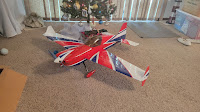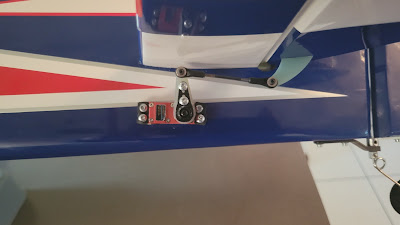
Having flown the 48" MXS for over a decade, this V2 was a much anticipated plane for me. I had fallen in love with my 60" V2 the instant I opened the box, and the 48" was much the same thing.
With V2 construction the planes are now much more durable and the fit and finish of everything is better than stellar. V2 construction also gives you a stiffer airframe, one that doesn't flex under load. You can tell the V2 stays straight and aligned the moment you turn after take-off. The airframe is largely unchanged externally, but the stiffer construction makes a big difference you can feel right away.
The V1 and V2s fly essentially the same except the V2 does everything a little better simply because it is more refined. Add to that better precision thanks to the increased stiffness and you've got a better airplane.
The best way to sum up the MXS is that it is a lot like you would expect from a short coupled Extra. The MXS is much more lively, though it surrenders a little to the Extra in precision flying. These two are very similar, except the Extra is biased a little more toward smooth, precise flying and the MXS is tailored more toward better agility and more violent snapping.
For 3D, the MXS' short coupling gives you better control authority. You can spin the MXS around in a tighter harrier turn, so this is a great plane for smaller fields. Harrier manners are very, very good, but you can see that in the video. Overall, while similar to the Extra, the MXS is still different enough in flying manners that both are worth having. They are just biased a little one way or the other on the precision vrs agility scale.
While different, I fly them relatively the same. The MXS is stronger than the Extra in some maneuvers and the opposite is true in others.
Overall, I think the MXS is a good second 3D aircraft. It's a very stable plane, but the level of agility is maybe a bit too much to be learning 3D on. Most people like the Edge for 3D training, but once you get past that most pilots will find the MXS' agility to be useful and even amusing. If you are already flying an Extra, you can jump into an MXS and feel pretty much at home right away.
Of the 3 currently available 48s, I would rate the Edge as the best plane for people learning 3D, but it still does very crisp precision. The Extra for most precise plane in the lineup, but still 3Ds extremely well. The MSX is for those who want the no compromises, hardcore king of badass.
Finally, the only way to really judge a plane is in how much fun you have with it, and the MXS has always delivered on that front. The MXS has always been a really special plan for me and now it is much, much nicer all the way around, and flies better too.











































